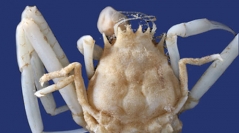

 Zoosystema
43 (4) - Pages 79-100
Zoosystema
43 (4) - Pages 79-100Adult female dajid isopods are ectoparasites found on carapaces, within marsupia, or rarely attached to the eyestalks or pereopods of crustacean hosts. We describe two new genera and species whose females exhibit a novel spheroid shape and envelope antennules of hosts: Akrophryxus milvus n. gen., n. sp. parasitizing Ethusa machaera Castro, 2005 (Madagascar, c. 900 m) and Telephryxus clypeus n. gen., n. sp. parasitizing Munidopsis crassa Smith, 1885 (Caribbean, c. 5000 m). Females of both species differ from other dajid species in their spheroid shape and a plate partially surrounding the host antennule; males are distinguished by reduction of pereopods. Females of A. milvus n. gen., n. sp. are distinguished from those of T. clypeus n. gen., n. sp. in possessing antennules and a triangular attachment plate with three holes (T. clypeus n. gen., n. sp. lacks antennules and the broad attachment plate has two medial holes). Males of A. milvus n. gen., n. sp. are distinguished from those of T. clypeus n. gen., n. sp. in having only six pairs of pereopods, rudimentary antennules, single segmented antennae, and pleon fused to pereomere 7 (T. clypeus n. gen., n. sp. with rudimentary seventh pair of pereopods, large single segmented antennules, two segmented antennae, and pleon distinct from pereomere 7). Pre-molt epicaridium larvae and cryptoniscus larvae of T. clypeus n. gen., n. sp. are described. We also describe Aegophila cappa n. sp. found on pereopods of the isopod Aegiochus symmetrica (Richardson, 1905) (Bering Sea, c. 650 m), distinguished from the type species of Aegophila Bresciani, 1966 by oostegite morphology of the female, form of the antennae, and shape of the pleon of males. Tables with comparative characters for genera of Dajidae G. O. Sars, 1883 are provided. Dajid life cycles and development are reviewed.
abyssal, Aegiochus, antennule parasite, Ethusa, Isopoda, life cycle, Munidopsis, new species, new genus